What I am going to present to you is my own case study about my golden retriever, Benjamin. It was through Ben that I met Karen Pryor and, thus, found some of the most effective ways to deal with aggression and fear-based behavior in dogs.
I purchased Ben from a breeder at seven weeks of age with the intent of showing him in competition obedience. At the age of five months, we started working with a wonderful obedience competition coach by the name of Patty Ruzzo, who employs purely operant conditioning training techniques. Ben blossomed under her tutelage.
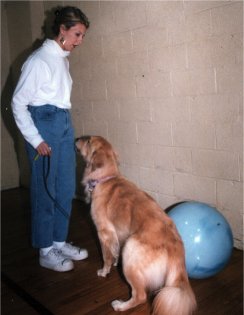
At the age of 7 months, I started to notice that Ben would growl occasionally at other dogs. He would bark at them and hastily pull me towards them. I was not sure of his intent. Frightened by this behavior, I sought help from an aggression expert in my area. I knew that physical corrections might be used to deal with Ben's reactivity, however, I had no idea of the trauma that Ben and I were about to experience.
As Ben and I walked toward the trainer, Ben barked and started pulling me towards the instructor's dog. The instructor proceeded to put his dog into the Down position, walked over to Ben as he quieted, and hung him severely on his prong collar. The first time he lifted Ben off of the ground, Ben bared his teeth at him. This was met with an even harder correction. The second time Ben was hung, he finally submitted. The instructor lowered Ben to the ground, at which point, Ben urinated and defecated all over himself. At the end of the session, the instructor handed me back my leash and said, "This is what you need to do the next time Ben shows any aggressive cues to another dog." I knew this was not going to be possible. Not only was I physically unable to lift Ben as this man had done, but I was horrified by the severity of the corrections given. I would rather euthanize Ben than treat him in such an abusive manner.
I didn't realize how much damage was done, until about a week later, when I took Ben to an obedience club. In the parking lot, upon the mere sight of another dog, Ben flew into a rage. He lunged, bared his teeth, and screamed, as globs and globs of saliva started dripping from both sides of his mouth. Again, I was horrified. I tried to keep him in the environment to see how long the reaction would last, but once he started vomiting, I knew we had to leave. Now what could I do? The side effects from Ben's punishment were much more traumatic than the original behavior we started with. Though I contemplated whether or not this trainer could help us, in my ignorance, I never suspected that he could cause the behavior to worsen.
Ben had no threshold level. He would aggress at a dog two feet away as well as twenty feet away. He would react not only to the physical presence of dogs in the environment but also to things like dogs on TV, car doors opening, or the jingle of car keys. Desperately, I began to search for seminars or conferences that were offered on helping to curb aggression in dogs. This is how I met Karen Pryor.
I met Karen in Hawaii, only to find out that she lived forty-five minutes from me, while she was giving a talk for the National Association of Dog Obedience Instructors, of which I had just become a member. During lunch, I sheepishly went up to her and asked her how to treat my dog-aggressive golden retriever. Her answer, "Start clicking somewhere in the middle of the aggressive cues. Spaces will open up." When I asked where I should click, since these cues come fast and furious, she asked, "He does breathe doesn't he? Watch his breath. Click as he's taking a breath."
To work on this problem, Ben and I were invited to attend a class that Karen was teaching in our area. Participation was by closed invitation only. Each student had a particular project that they were working on: some worked with autistic children (learning techniques through their dogs), some worked with obedience and agility, Ben and I worked on aggression. This class originally was going to stay together for 9 weeks; however, we enjoyed the class so much that we decided to stay together for nine months! Karen has written extensively about this class in the American Kennel Club's magazine The Gazette.
The Rehabilitation Process These were the four steps of Ben's rehabilitation process. I also use these steps when I am treating a client's dog depending on where he might fall on the "reactive" continuum.
Effective home management: teaching the dog to allow the humans in the household to make the right decisions for him. If it is not happening in the home, it certainly is not going to happen in the real world, especially if the dog considers it a "dangerous" environment. Foundation behaviors are taught via clicker training, so that after the dog learns to think in the environment, he might perform the desired behaviors. Foundation behaviors include: sit, down, heel, stay, targeting, holding an object, kennel up on audible cue, come and sit front, leave it, come when called, and get behind.
Create a "thinking" dog: I am convinced that when Ben saw another dog, he reacted involuntarily. Once in this cycle, he could not stop, even when my husband picked him up off of a dog and brought him into another room. Ben still kept reacting as if nothing had changed. In order for a dog to look at his owner for direction, he needs to be able to make that deliberate decision to do so. He needs to be able to think in that environment.
Insert incompatible behaviors: Differential reinforcement of incompatible behaviors. What do you want your dog to do instead of aggressing at other dogs? Teach him what to do rather than teach him what not to do. It is only when the dog is a "thinking" dog that he is capable of making deliberate decisions. He can then perform single-cued behaviors that are incompatible with performing the aggressive behavior. "A busy dog has no time to be fearful," as Karen would say.
Teach more advanced skills: What are your final goals? With Ben, I just wanted a dog that looked "normal" when I walked him down the street. Some of my clients want their dogs to have "friends." Whatever the case, decide how to take the behavior to the next level via the principles of learning theory.
The Process of Extinguishing Aggressive Cues First, I needed to take the "lunging" behavior out of the aggressive display, so I put Ben on a Gentle Leader head collar. This served the purpose well. Even though Ben did not like the collar, despite many attempts at desensitizing him to it beforehand, it served beautifully as a deterrent when I needed to simply get him into an environment, with even just one other dog.
I began to click and treat Ben at the lowest points of the intensity of the aggressive behavior. This is the differential reinforcement of lower intensity behavior or DRL. I knew that if I could catch these quieter pieces, this would help to lower the frequency and intensity of the aggressive cues across the board. I tried to shut off the "noise" and focus on his breathing. (Please note that it took Ben about two months to begin eating the treats during these sessions. I would click, attempt to feed him, and he would just let the treats fall to the ground. After the session, I would sadly sweep them up. Karen had mentioned that Ben would eat when he was ready, but in the meantime, keep clicking. The sound of the click is thought to be calming to the amygdala of the brain.)
As we continued working in this manner, I started to notice that tiny windows of silence started to open up. As these windows became more plentiful, I now had more of a chance to click in the appropriate spots.
After successfully lessening the reactivity, now I could establish a threshold. How far away would Ben have to be to not react to another dog? Determining this distance was my next step.
After establishing the right distance, I could click and feed Ben for the absence of the aggressive cues. I worked in small, successful approximations. Initially, sessions ranged anywhere from 30 seconds to 2 minutes. With success, I worked in three-to-five minute increments and increased exposure from there.
It is here that I started clicking and feeding Ben for looking at and hearing other dogs in the environment. I also would click and feed him if another dog acted aggressively towards him. The payoff was big if another dog threatened Ben! I wanted Ben to learn how to look at other dogs without provoking an aggressive display.
The end result is that the presence of the other dog(s) in the environment becomes the cue, in itself, to look at you. Think about what this means! You no longer need to compete with the heavy distractions in the environment, physically struggling to get your dog's attention. Instead, the distraction of the other dogs in the environment becomes the cue, in itself, to look at you! Now that you have eye contact, you can cue the appropriate incompatible behaviors. Foundation Behaviors work beautifully here.
Teaching Dog-to-Dog Interaction As Ben progressed in his training program, I taught him how to interact with dogs more successfully. For example, I taught him how to target another dog's body on cue. This made every dog he met a "clickable" encounter. It totally changed his attitude about getting close to other dogs.
I also taught him that it was a great thing for other dogs to touch him. He would get clicked and fed for other dogs touching or sniffing him. This was to prepare him for the real world when other owners would allow their dogs to go up to him despite my previous protests.
In summary, clicker training is so effective in treating aggressive cues because it is able to mark the correct behavior so precisely. Sometimes one can't click fast enough! The clicker means the same thing, all the time, no matter who is holding the clicker. It conveys confidence, even if one's hand is sweating in apprehension. Also, as mentioned above, the sound of the click is thought to be calming to the amygdala of the brain. The brain interprets it faster than a spoken word. Lastly, learning is enhanced because you are using classical and operant conditioning principles simultaneously.
Emma Parsons can be reached at creativk9@aol.com. Emma is a clicker trainer and the author Click to Calm: Healing the Aggressive Dog.
- See also, The Latham Letter Vol 22, #1 Page 16-18 Winter 2001 (pdf)


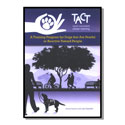
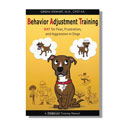
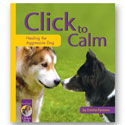
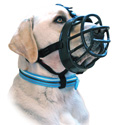
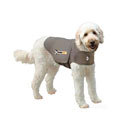

Agressive Golden
All I can say is that I would have sued the pants off of anyone who abused my dog like that. I am so glad you were able to help your dog overcome this by clicker training and give you credit for not giving up. I also give you credit for not publishing his name although I would really like to know so that no one that I know would ever put their dog at the mercy of this trash.
Ben: An Aggressive Dog Case Study
Hi, Emma. I enjoyed your article about "Ben: An Aggressive Dog Case Study." You mentioned, however, that Patty Ruzzo "employs purely operant conditioning training techniques." Operant conditioning includes positive reinforcement, negative punishment, and extinction. Unfortunately, it also includes positive punishment and negative reinforcement, techniques we "dog-friendly" trainers prefer not to use. May I please respectfully suggest you should say something like "Patty employs purely 'positive' training techniques"? Yes, yes, yes, I know "positive" can be a scientifically ambiguous term. However, in the context in which you wrote, I feel "Patty employs purely 'positive' training techniques" would have been a more-clearly received statement. What do you think?
Really great
I found this site via a link on the Leerburg forum and am so glad I did :)
I rescued a male Labrador six months ago and recently he's started going beserk when any other dog on a leash is nearby. He lunges, barks, growls, it's horrendous.
We are working with a trainer and while she's helped a lot with his other issues, her advice re this leash aggression is simply not working. I have a clicker and am going to start researching this. Thank you so much for sharing your experiences!
Agressive Behavior
Thank you so much for sharing this Great ending in using the Clicker. It inspires me to use it more with my Chihuahua than I have before and keep it handy for those good behaviors. If I use it more then I believe my Chihuahua will also sense the elimination more effectively as well. Thanks again for the shared experience.
WOW
That was such a heart felt story. Thank you for sharing it with us!! As I have a German Shepherd and she is agressive as well whic does not help the situation at all. I know what it feels like when you cannot be comfortable around other dogs with your dog beside you, as you are scared it will lunge out at them.
You have given me so much hope for Indie, my dog. THANK YOU!!!
:D
THANKYOU!
I cant believe it. I have an aggressive goldie toO!!!!
Ben's story
It was hard for me to read about Ben's experience with the first trainer. I have been on the other side of that myself, almost as severe. I hated feeling so powerless to protect my dog. I knew instinctively, that it was so wrong. But one never really knows how severely it could affect a particular dog. I am looking forward to reading your book.
Rita Ippolito
www.savagemermaidswildpugs.com
Shih Tzu problems
I just registered with you and my husband bought a clicker training kit. We adopted Oreo, a Shih Tzu, at the Humane Society on March 25th and have been having some real problems with dominance aggression, especially with me, ever since. Whenever I am alone with Oreo, he demands my full attention and wants to play all the time. His idea of playing is biting me on the feet (pretty hard at times) and on my legs and lunging at me. He also bites my fingers and arms whenever I sit down to read. I have tried being firm with him, yelping, yelling NO! in a loud voice, time outs, making him sit, etc. etc. Nothing works! It is becoming a real problem. We want to persist and train him but this lunging and biting me is wearing me down. What should I do? The clicker kit should be on its way, I guess. Does it have any ideas about this particular problem?
Also on our walks, I am trying to teach him to heel. He takes it for a while, but when we encounter another dog or even a person, and I do not let him get his way, he bites my ankles and legs and generally makes it difficult to manage him at all. My husband and I have even mentioned bringing him back to the Humane Society, it has become so unpleasant. If you have any insights or ideas, please help me. We have also thought of going to a training class.
At my wits end,
Charlotte
excitement and biting...
this is just a thought! sounds like he gets excited and reactive and turns it on you. Have you read Adian's blog on aggression and the 'calm o meter'?
Check them out and don't give up. Finding a good CALM trainer would be very helpful. Also Emma Parson's book...Click to Calm
Rita Ippolito
www.savagemermaidswildpugs.com
Post new comment